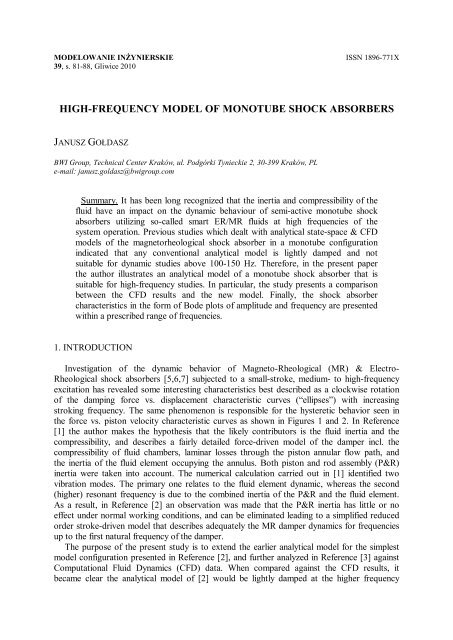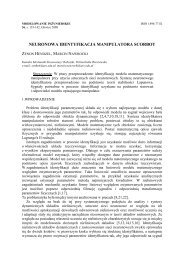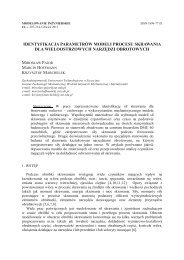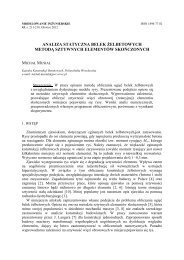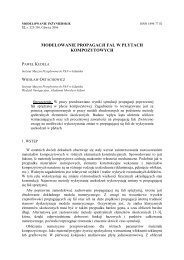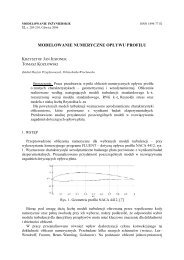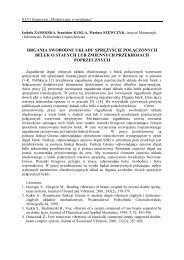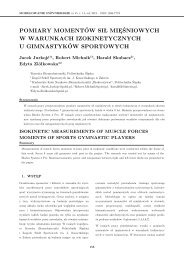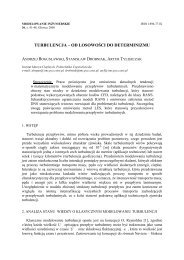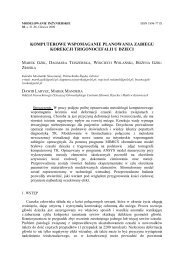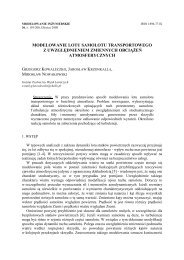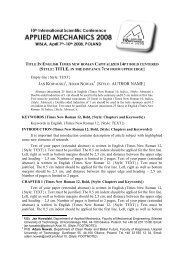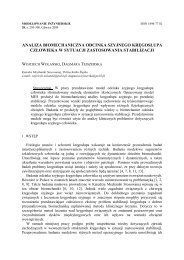HIGH-FREQUENCY MODEL OF MONOTUBE SHOCK ABSORBERS
HIGH-FREQUENCY MODEL OF MONOTUBE SHOCK ABSORBERS
HIGH-FREQUENCY MODEL OF MONOTUBE SHOCK ABSORBERS
You also want an ePaper? Increase the reach of your titles
YUMPU automatically turns print PDFs into web optimized ePapers that Google loves.
<strong>MODEL</strong>OWANIE INŻYNIERSKIE ISSN 1896-771X<br />
39, s. 81-88, Gliwice 2010<br />
<strong>HIGH</strong>-<strong>FREQUENCY</strong> <strong>MODEL</strong> <strong>OF</strong> <strong>MONOTUBE</strong> <strong>SHOCK</strong> <strong>ABSORBERS</strong><br />
JANUSZ GOŁDASZ<br />
BWI Group, Technical Center Kraków, ul. Podgórki Tynieckie 2, 30-399 Kraków, PL<br />
e-mail: janusz.goldasz@bwigroup.com<br />
Summary. It has been long recognized that the inertia and compressibility of the<br />
fluid have an impact on the dynamic behaviour of semi-active monotube shock<br />
absorbers utilizing so-called smart ER/MR fluids at high frequencies of the<br />
system operation. Previous studies which dealt with analytical state-space & CFD<br />
models of the magnetorheological shock absorber in a monotube configuration<br />
indicated that any conventional analytical model is lightly damped and not<br />
suitable for dynamic studies above 100-150 Hz. Therefore, in the present paper<br />
the author illustrates an analytical model of a monotube shock absorber that is<br />
suitable for high-frequency studies. In particular, the study presents a comparison<br />
between the CFD results and the new model. Finally, the shock absorber<br />
characteristics in the form of Bode plots of amplitude and frequency are presented<br />
within a prescribed range of frequencies.<br />
1. INTRODUCTION<br />
Investigation of the dynamic behavior of Magneto-Rheological (MR) & Electro-<br />
Rheological shock absorbers [5,6,7] subjected to a small-stroke, medium- to high-frequency<br />
excitation has revealed some interesting characteristics best described as a clockwise rotation<br />
of the damping force vs. displacement characteristic curves (“ellipses”) with increasing<br />
stroking frequency. The same phenomenon is responsible for the hysteretic behavior seen in<br />
the force vs. piston velocity characteristic curves as shown in Figures 1 and 2. In Reference<br />
[1] the author makes the hypothesis that the likely contributors is the fluid inertia and the<br />
compressibility, and describes a fairly detailed force-driven model of the damper incl. the<br />
compressibility of fluid chambers, laminar losses through the piston annular flow path, and<br />
the inertia of the fluid element occupying the annulus. Both piston and rod assembly (P&R)<br />
inertia were taken into account. The numerical calculation carried out in [1] identified two<br />
vibration modes. The primary one relates to the fluid element dynamic, whereas the second<br />
(higher) resonant frequency is due to the combined inertia of the P&R and the fluid element.<br />
As a result, in Reference [2] an observation was made that the P&R inertia has little or no<br />
effect under normal working conditions, and can be eliminated leading to a simplified reduced<br />
order stroke-driven model that describes adequately the MR damper dynamics for frequencies<br />
up to the first natural frequency of the damper.<br />
The purpose of the present study is to extend the earlier analytical model for the simplest<br />
model configuration presented in Reference [2], and further analyzed in Reference [3] against<br />
Computational Fluid Dynamics (CFD) data. When compared against the CFD results, it<br />
became clear the analytical model of [2] would be lightly damped at the higher frequency
82 J. GOŁDASZ<br />
regime, and a mechanism for accounting for the viscosity (and the inertia) of the fluid<br />
throughout the damper should be investigated and added to the analytical models in order to<br />
improve its fidelity at frequencies near the resonance. As such, in the present paper a<br />
hydraulic network type model of a shock absorber is designed and tested in order to confirm<br />
the CFD study conclusions. Therefore, in Section 2.1 the author outlines the hydraulic<br />
network approach and the dynamic model of the shock absorber, and Section 2.2 contains<br />
details of the CFD experiment performed by the author in order to test the network model.<br />
Sections 2.3 and 2.4 contain damper configuration specific data and damper test setup<br />
information, respectively. Finally, the results are presented in Section 2.5 and the conclusions<br />
drawn in Section 3.<br />
1000<br />
800<br />
600<br />
10 Hz<br />
15 Hz<br />
20 Hz<br />
25 Hz<br />
400<br />
Force, [N]<br />
200<br />
0<br />
-200<br />
-400<br />
-600<br />
-800<br />
-1000<br />
-1 -0.8 -0.6 -0.4 -0.2 0 0.2 0.4 0.6 0.8 1<br />
Speed, [m/s]<br />
Figure 1. Off-state (zero current) force-velocity phase plane<br />
1000<br />
800<br />
600<br />
10 Hz<br />
15 Hz<br />
20 Hz<br />
25 Hz<br />
400<br />
Force, [N]<br />
200<br />
0<br />
-200<br />
-400<br />
-600<br />
-800<br />
-1000<br />
-6 -3 0 3 6<br />
Stroke, [mm]<br />
Figure 2. Off state force-displacement phase plane
<strong>HIGH</strong>-<strong>FREQUENCY</strong> <strong>MODEL</strong> <strong>OF</strong> <strong>MONOTUBE</strong> <strong>SHOCK</strong> <strong>ABSORBERS</strong> 83<br />
2. <strong>MODEL</strong>ING AND SIMULATIONS<br />
2.1. Shock absorber model<br />
Consider the monotube damper configuration shown in Figure 3 and the simplified<br />
configuration in Figure 4. The cylinder tube houses the floating piston (gas cup) which<br />
separates the fluid from the pressurized gas. The main piston separates the upper and lower<br />
fluid chambers and includes an annular passage to permit the fluid to flow from one chamber<br />
to the other. In the present study the annulus is approximated by flat-plate geometry of length<br />
(area) L g (A g ). The shock absorber fluid is characterized by the three parameters: the density ρ,<br />
the bulk modulus β, and the viscosity μ; the magnetic field is absent, and the fluid behavior is<br />
Newtonian. Therefore, the fluid flow through the annulus produces viscous damping forces.<br />
Figure 3. Monotube damper configuration [1]<br />
Figure 4. Reduced (velocity-driven) damper configuration<br />
and its lumped parameter model [2]<br />
In order to account for the viscous losses across the whole shock absorber volume, the<br />
fluid volumes on either side of the main piston were modeled as a hydraulic network of<br />
inertia, compliance and viscous resistance elements. Figure 5 shows the lumped parameter<br />
approximation of mass-spring portion of the (compliant) fluid volume. The inertia factor of a<br />
single lump of length L i (and the volume V 0,i ) is then equal to ρL i /A i , whereas the compliance<br />
of the lump is β/V 0,i . The annulus cross-sectional area is A i . .Then, the corresponding<br />
equations of motion for the lump i at mid-stroke conditions are as follows<br />
ìdQi<br />
ï =<br />
Ai<br />
P<br />
ï<br />
dt ρLi<br />
ïdPin<br />
β<br />
i<br />
í =<br />
ï dt V 0, i<br />
ïdPout<br />
β<br />
i<br />
ï<br />
=<br />
î dt V0,<br />
i<br />
128µ<br />
Li<br />
Ri<br />
4<br />
πd<br />
i<br />
( - - )<br />
in<br />
P<br />
( Q -Q<br />
)<br />
in<br />
( Q -Q<br />
)<br />
i<br />
out<br />
i<br />
out<br />
RiQ<br />
i<br />
= (2)<br />
(1)
84 J. GOŁDASZ<br />
where P in , P out are the pressures in and out of the lump, and Q in , Q out are the volume flow rates<br />
associated with the pressures, respectively. R i accounts for the hydraulic resistance of the<br />
lump, and d i refers to the lump hydraulic diameter. Assuming laminar flow losses, the term<br />
can be given by Equation 2. For example, the equations of motion of a model consisting of<br />
three lumps (N=3) can be described in the following manner<br />
ì dP1<br />
β<br />
ï<br />
= (-Q<br />
)<br />
1<br />
dt<br />
ï<br />
V 0,1<br />
ïdQ1<br />
=<br />
A1<br />
ï<br />
P1<br />
P2<br />
dt ρL1<br />
ï<br />
ï<br />
dP2<br />
β<br />
=<br />
1 Ap<br />
ï dt V 0,2<br />
ïdQ2<br />
Ag<br />
í = P2<br />
P3<br />
ï<br />
dt ρLg<br />
ïdP3<br />
β<br />
ï<br />
=<br />
2 Ap<br />
dt V 0,3<br />
ï<br />
ïdQ3<br />
=<br />
A3<br />
P3<br />
P4<br />
ï dt ρL3<br />
ï<br />
ï<br />
dP4<br />
β<br />
= ( Q3)<br />
ïî<br />
dt V0,4<br />
( - - )<br />
R1Q<br />
( Q + v -Q<br />
)<br />
( - - Q )<br />
R<br />
( Q - v -Q<br />
)<br />
( - - Q )<br />
where v is the input velocity of the piston. In the above model shown in Figure 6 the flow<br />
rates Q 2 , Q 3 and the pressures P 2 and P 3 , respectively, drive the motion of the fluid element<br />
contained in the annular gap of the main piston. The area of the piston is A p . The remaining<br />
variables account for the behavior of the corresponding fluid lumps. Note the above equations<br />
correspond to the simplified shock absorber configuration with no gas chamber in Figure 4.<br />
R<br />
3<br />
p<br />
1<br />
2<br />
3<br />
3<br />
2<br />
(3)<br />
Figure 5. Hydraulic network lump<br />
Figure 6. Hydraulic network model; N=3<br />
As a result, the damping force across the piston can be obtained from<br />
= ( )<br />
(4)<br />
F<br />
A<br />
P<br />
P<br />
d p 2 - 3<br />
The equation set can be easily cast into the state-space form, thus yielding<br />
T<br />
where X = [ P1<br />
P2<br />
P3<br />
P4<br />
Q1<br />
Q2<br />
Q3]<br />
. Therefore,<br />
dX<br />
= AX + Bv<br />
(5)<br />
dt
<strong>HIGH</strong>-<strong>FREQUENCY</strong> <strong>MODEL</strong> <strong>OF</strong> <strong>MONOTUBE</strong> <strong>SHOCK</strong> <strong>ABSORBERS</strong> 85<br />
A =<br />
0<br />
0<br />
0<br />
0<br />
A1<br />
ρL<br />
0<br />
0<br />
1<br />
0<br />
0<br />
0<br />
0<br />
A1<br />
-<br />
ρL<br />
A2<br />
ρL<br />
0<br />
2<br />
1<br />
0<br />
0<br />
0<br />
0<br />
0<br />
A2<br />
-<br />
ρL<br />
A3<br />
ρL<br />
3<br />
2<br />
0<br />
0<br />
0<br />
0<br />
0<br />
0<br />
A3<br />
-<br />
ρL<br />
3<br />
β<br />
-<br />
V<br />
β<br />
V<br />
0,2<br />
0<br />
0<br />
0,1<br />
A1<br />
- R1<br />
ρL<br />
0<br />
0<br />
1<br />
β<br />
-<br />
V<br />
β<br />
V<br />
- R<br />
0<br />
2<br />
0,2<br />
0,3<br />
0<br />
0<br />
0<br />
A2<br />
ρL<br />
2<br />
β<br />
-<br />
V<br />
β<br />
V<br />
0<br />
0<br />
0,3<br />
0,4<br />
0<br />
0<br />
A3<br />
- R3<br />
ρL<br />
3<br />
(6)<br />
B =<br />
0<br />
0<br />
0<br />
0<br />
0<br />
0<br />
0<br />
0<br />
0<br />
0<br />
0<br />
0<br />
0<br />
0<br />
0<br />
0<br />
0<br />
0<br />
0<br />
0<br />
0<br />
0<br />
0<br />
0<br />
0<br />
0<br />
0<br />
0<br />
0<br />
2<br />
β<br />
A<br />
V 0,2<br />
A2<br />
- β<br />
V<br />
0<br />
from which the (linear) network transfer function between the output force and the input<br />
velocity can be easily deduced in an analytical fashion.<br />
2.2. CFD model<br />
The FLUENT unsteady 2D-axisymmetric model configuration shown in Figure 7<br />
corresponds to the simple shock absorber model explored in [2] and shown in Figure 4; the<br />
reader should refer to the paper for further information. Shortly, the piston rod is neglected,<br />
and the piston motion is prescribed as a sinusoidal velocity profile to reflect the actual testing<br />
conditions of real dampers. In the analysis dynamic layering algorithm in FLUENT was used<br />
to adjust the model mesh according to the prescribed motion profile. Finally, the damping<br />
force was obtained by integrating pressure distributions on either side of the piston.<br />
0<br />
0<br />
0<br />
0,3<br />
0<br />
0<br />
0<br />
0<br />
0<br />
0<br />
0<br />
0<br />
0<br />
0<br />
0<br />
0<br />
0<br />
0<br />
(7)<br />
Figure 7. CFD monotube damper model<br />
(only the annulus with adjacent regions is shown) [3]
86 J. GOŁDASZ<br />
2.3. Actuator Geometry and Material Properties<br />
Table 1 reveals the key actuator dimensions and material properties used in the analytical<br />
model setup as well as the CFD analysis.<br />
2.4. Test setup<br />
Table 1. Actuator geometry and material properties<br />
Parameter<br />
Value<br />
Fluid dynamic viscosity<br />
30 cP<br />
Bulk modulus<br />
220 MPa<br />
Fluid density<br />
2.5 g/cc<br />
Area factor 1662 mm 2<br />
Annulus size<br />
0.7 mm<br />
Annulus length<br />
30 mm<br />
Annulus area 80 mm 2<br />
Chamber length<br />
100 mm<br />
No. of lumps, N {1,3,5}<br />
The CFD model is exercised in such a manner to copy the testing of real shock absorbers<br />
on a hydraulic stroker, i.e., the cylinder tube is fixed while the piston is stroked with a<br />
sinusoidal constant-velocity profile at discrete frequencies (and with ever-decreasing<br />
displacement). The stroking frequencies range from 3 to 390 Hz, as the stroke is varied from<br />
the peak-to-peak value of 16 mm down to 0.12 mm at the final frequency of 390 Hz. As a<br />
consequence, the peak velocity of the driving piston is held constant at 0.15 m/s at all<br />
frequencies.<br />
Clearly, the hydraulic network model is exercised in a manner similar to that of the CFD<br />
experiment to enable a direct comparison of the model performance against the CFD data.<br />
2.5. Results<br />
To analyze the influence of the number of lumps in the hydraulic network model numerical<br />
tests involving the model with N={1, 3, 5} lumps were performed within the prescribed range<br />
of input frequencies, respectively. The results are presented in Figures 9-10 as plots of the<br />
amplitude and phase angle against frequency. At first, the model was configured with the<br />
laminar model in the flow path for both piston and cylinder sections. In general, the linear<br />
approach is not satisfactory even for the relatively low speed regime considered in the study.<br />
While the linear model approaches the natural frequency of the CFD model as the number of<br />
lumps increases, the damping force amplitude at that frequency is still overestimated by a<br />
factor of 3 (for a model with 5 lumps). Therefore, the author decided to enhance the each<br />
lump with a hydraulic resistance term that is proportional to flow rate squared ( Qi2 ) to account<br />
for entry/exit losses in the annulus, for example. The magnitude of these components was<br />
estimated from CFD steady-state tests. Adding the quadratic damping term improved the<br />
model. As seen in Figures 8, 9 and 10, it can be noted that the modified network model is<br />
approaching the natural frequency of the shock absorber and the amplitude as well as phase.<br />
The model, however, still overestimates the amplitude of the damping force at resonance.
<strong>HIGH</strong>-<strong>FREQUENCY</strong> <strong>MODEL</strong> <strong>OF</strong> <strong>MONOTUBE</strong> <strong>SHOCK</strong> <strong>ABSORBERS</strong> 87<br />
4000<br />
3500<br />
CFD<br />
<strong>MODEL</strong><br />
<strong>MODEL</strong>: 268 Hz<br />
3000<br />
]<br />
[<br />
N<br />
,<br />
e<br />
c<br />
r<br />
o<br />
F<br />
2500<br />
2000<br />
1500<br />
CFD: 220 Hz<br />
1000<br />
500<br />
0<br />
10 0 10 1 10 2 10 3<br />
Frequency, [Hz]<br />
Figure 8. CFD vs. state-space model [3]<br />
2000<br />
N=1<br />
N=3<br />
N=5<br />
CFD Results<br />
MOD. <strong>MODEL</strong> (N=1): 268 Hz<br />
1500<br />
]<br />
[<br />
N<br />
,<br />
e<br />
c<br />
o<br />
F<br />
1000<br />
CFD: 220 Hz<br />
500<br />
0<br />
10 0 10 1 10 2 10 3<br />
Frequency, [Hz]<br />
Figure 9. Force vs. frequency; modified hydraulic network model<br />
3. SUMMARY AND CONCLUSIONS<br />
The purpose of the paper was to illustrate the analytical model of a monotube shock<br />
absorber that is suitable for engineering purposes. That model can be used in higher frequency<br />
vehicle suspension simulations instead of more complex CFD or phenomenological models.<br />
In order to account for damping in the cylinder sections of the damper as well as fluid<br />
compressibility and inertia, the (simplified) device was modeled as a hydraulic network of<br />
lumped mass, compliance and viscous resistance elements. For comparison, the previous<br />
analytical models [1,2] assumed viscous losses only in the annulus of the piston and inviscid<br />
fluid elsewhere. When compared to the CFD experiment, the models were lightly damped. It<br />
seems the hydraulic network is better at capturing the natural frequency of the model.<br />
However, the model still overestimates the damping force at that frequency which indicates<br />
some work on the damping (viscous loss) component of the network model is still required.
88 J. GOŁDASZ<br />
100<br />
50<br />
]<br />
g<br />
e<br />
[<br />
d<br />
,<br />
e<br />
s<br />
a<br />
h<br />
P<br />
0<br />
-50<br />
N=1<br />
N=3<br />
N=5<br />
-100<br />
150 200 250 300 350 400<br />
Frequency, [Hz]<br />
Figure 10. Phase shift vs. frequency; modified hydraulic network model<br />
REFERENCES<br />
1. Alexandridis A. A., Gołdasz, J.: High-frequency Dynamics of Magneto-Rheological<br />
Dampers. In: Proceedings of the Ninth International Conference on New Actuators<br />
(“ACTUATOR 2004”), Bremen, Germany, 14-16 June, 2004.<br />
2. Alexandridis A. A, Gołdasz J.: Simplified model of the dynamics of magneto-rheological<br />
dampers. “Mechanics” 2005, Vol. 24(2), p. 47-53.<br />
3. Gołdasz, J., Alexandridis A. A.: Frequency-dependent behavior of MR dampers: CFD<br />
Study. In: Proceedings of the Active Noise and Vibration Control Methods Conference<br />
(“MARDiH 2007”), Krasiczyn, Poland, 11-14 June, 2007.<br />
4. Peel D. J., Stanway R., Bullough W. A.: Dynamic modeling of ER vibration damper for<br />
vehicle suspension applications. „Smart Materials and Structures“ 1996, Vol. 5, p. 591-<br />
606.<br />
5. Hopkins P. N.: Magnetorheological fluid damper. US Patent 6311810, 2001.<br />
6. Petek, N.: Adjustable dampers using electrorheological fluids. US Patent 5259487, 1993.<br />
7. Nguyen Q.-H., Choi S.: A new approach for dynamic modeling of an electrorheological<br />
damper using a lumped parameter method, Nguyen, Quoc-Hung; Choi, Seung-Bok,<br />
“Smart Materials and Structures” 2009, Vol. 18(11), p. 115 – 120.


